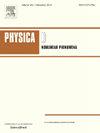Boundary and interior spikes in economic agglomeration of a spatial Solow model with capital-induced labor migration
IF 2.7
3区 数学
Q1 MATHEMATICS, APPLIED
引用次数: 0
Abstract
Economic geography seeks to explore uneven spatial development commonly known as economic agglomeration, where economic activities concentrate in specific regions. While a variety of factors have been studied to explain the emergence of core–periphery economic patterns, labor mobility emerges as a fundamental and indispensable driver of such heterogeneity within the spatial economic framework. The spatial Solow model under consideration incorporates both wealth diffusion and labor migration to analyze the spatio-temporal economic growth. Labor migration is influenced by a combination of an unbiased random walk without economic incentives and a biased movement toward regions with better economic opportunities due to uneven capital distribution. In the regime of a large capital-induced labor migration rate, we first prove the existence of a steady state with a single boundary spike, and then prove its linearized stability using its asymptotic profile; moreover, this spike can be reflected and periodically extended to construct more stationary configurations with aggregates featuring interior spike and/or double-boundary spike. Further theoretical analysis shows that the single interior spike is inherently unstable and the double boundary spike is linearly stable. These results suggest that intense capital-induced labor migration can drive and stabilize economic agglomerations, concentrating wealth and labor in specific areas. Numerical simulations support these findings, revealing additional spatio-temporal dynamics such as phase transitions and spike insertion, and showcase the framework’s ability to capture complex economic behaviors.
考虑资本劳动力迁移的空间索洛模型经济集聚的边界和内部峰值
经济地理学旨在探索通常被称为经济集聚的不平衡空间发展,经济活动集中在特定区域。虽然研究了多种因素来解释核心-边缘经济模式的出现,但劳动力流动在空间经济框架内成为这种异质性的基本和不可或缺的驱动因素。本文所考虑的空间索洛模型同时考虑了财富扩散和劳动力迁移来分析经济增长的时空。劳动力迁移受无经济激励的无偏随机游走和资本分布不均导致的向经济机会较好的地区的偏向性两种因素的影响。在资本诱导劳动力迁移率较大的情况下,首先证明了具有单边界尖峰的稳态的存在性,然后利用其渐近曲线证明了其线性化稳定性;此外,该尖峰可以反射并周期性地扩展,以构建具有内部尖峰和/或双边界尖峰的聚集体的更平稳的结构。进一步的理论分析表明,单内峰是固有不稳定的,双边界峰是线性稳定的。这些结果表明,资本引发的劳动力密集迁移可以驱动和稳定经济集聚,将财富和劳动力集中在特定地区。数值模拟支持这些发现,揭示了额外的时空动态,如相变和尖峰插入,并展示了框架捕捉复杂经济行为的能力。
本文章由计算机程序翻译,如有差异,请以英文原文为准。
求助全文
约1分钟内获得全文
求助全文
来源期刊

Physica D: Nonlinear Phenomena
物理-物理:数学物理
CiteScore
7.30
自引率
7.50%
发文量
213
审稿时长
65 days
期刊介绍:
Physica D (Nonlinear Phenomena) publishes research and review articles reporting on experimental and theoretical works, techniques and ideas that advance the understanding of nonlinear phenomena. Topics encompass wave motion in physical, chemical and biological systems; physical or biological phenomena governed by nonlinear field equations, including hydrodynamics and turbulence; pattern formation and cooperative phenomena; instability, bifurcations, chaos, and space-time disorder; integrable/Hamiltonian systems; asymptotic analysis and, more generally, mathematical methods for nonlinear systems.
 求助内容:
求助内容: 应助结果提醒方式:
应助结果提醒方式:


